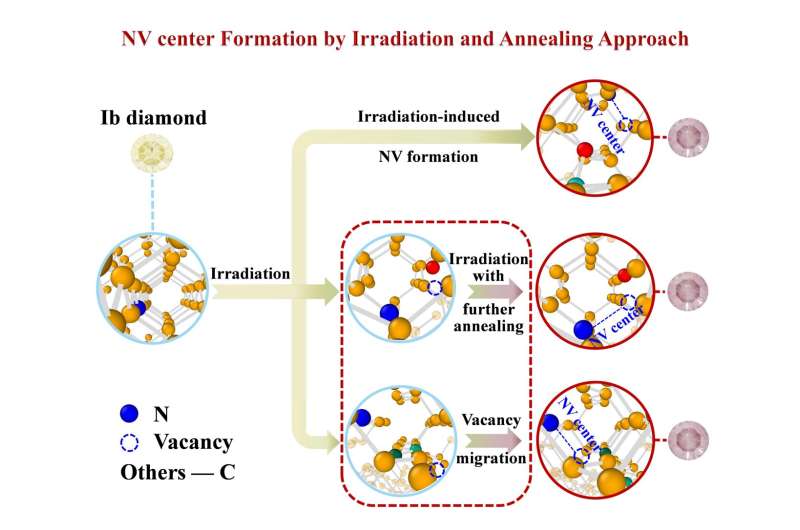
September 6, 2024 by Songshan Lake Materials Laboratory
Collected at: https://phys.org/news/2024-09-secrets-diamond-insights-nitrogen-vacancy.html
Research teams from Wuhan University and the China University of Geosciences (Wuhan) have revealed new insights into the formation mechanism of nitrogen-vacancies (NV) centers in type-Ib diamonds, a phenomenon critical to quantum sensing and computing advancements. Using a novel irradiation and annealing method, the teams demonstrated how controlled temperature and orientation can significantly increase the density and depth of NV centers, paving the way for new applications in biological imaging and quantum technologies.
The work is published in the journal Materials Futures.
This study not only advances our understanding of diamond materials, but it also opens up new possibilities for using their unique properties in cutting-edge scientific and technological applications. As diamonds continue to shine in the field of materials science, this study represents a significant step toward realizing their full potential.
The nitrogen-vacancy (NV) centers in diamonds, known for their exceptional sensitivity and spatial resolution, hold a crucial position in the fields of quantum sensing, quantum computing, biofluorescent labeling, temperature sensing, and magnetic field measurements. Over recent years, researchers have explored a variety of techniques for the preparation of NV centers, including chemical vapor deposition (CVD), high-energy particle irradiation, ion implantation, and femtosecond laser irradiation followed by annealing.
Among these methods, post-irradiation annealing has emerged as particularly promising, owing to its capacity to produce NV centers in high concentrations and at significant depths in diamond. However, the formation of NV centers is influenced by numerous factors, including the energy of the incident particles, annealing temperature, nitrogen concentration, and the concentration of vacancies created during irradiation.
Existing studies have demonstrated that high-energy particle irradiation followed by annealing can substantially increase the concentration of NV centers. Nonetheless, optimizing the process parameters for NV center formation remains challenging due to the complexity and high cost of the experiments, coupled with the lack of comprehensive theoretical support. As a result, the atomic-scale processes governing NV center formation remain insufficiently understood.
As a solution, the researchers have employed MD simulations, first-principles calculations, and experimental verifications to reveal the microscopic mechanisms and defect evolution process of NV centers prepared by irradiation-annealing of type-Ib diamond.
Different incident directions ([111], [110] and [100]) and annealing temperatures (973 K, 1,073 K and 1173 K) are considered. The results indicate that NV centers can be formed by three microscopic mechanisms, namely irradiation-induced NV formation (INF), irradiation with further annealing (IFA) and vacancy migration (VM) toward nitrogen to form NV centers.
The threshold annealing temperature for vacancy migration depends on the orientation, with average values of 613.6 K, 700.5 K, and 531.8 K along the [111], [110], and [100] directions, respectively. It is important to note that a higher annealing temperature does not guarantee a higher yield of NV center formation, as it also depends on the crystallographic orientation. This work provides valuable insights into the formation mechanism and further controlled preparation of NV centers.
These three formation mechanisms are featured in MD simulations, first principles calculation and experiments of irradiation and annealing, enhancing the comprehension of the formation mechanism of NV centers. The three formation strategies of NV centers are as follows: irradiation-induced NV formation, irradiation with further annealing to form NV, and vacancy migration to form NV. The vacancy interchanges with nearby carbon atoms stepwise, rather than by hopping. Additionally, the annealing temperature exhibits orientation-dependent effects on vacancy migration and NV center formation, indicating that higher annealing temperatures do not necessarily result in a higher yield of NV centers.
Future research will aim to enhance the controllable preparation of NV centers, with an emphasis on minimizing experimental costs.
This work provides a comprehensive atomic-level understanding of NV center formation in diamonds, presenting a promising approach for the controllable preparation of NV centers.
More information: Taiqiao Liu et al, Insights into the Nitrogen-vacancy Center Formation in Type-Ib Diamond by Irradiation and Annealing Approach, Materials Futures (2024). DOI: 10.1088/2752-5724/ad727a

Leave a Reply